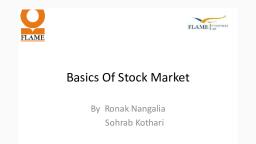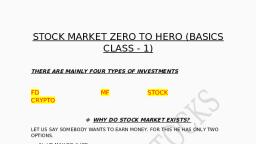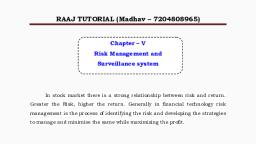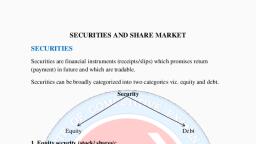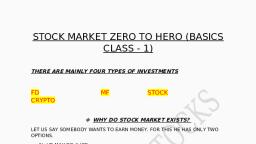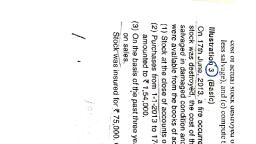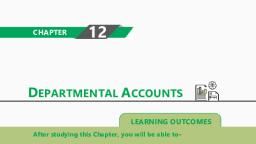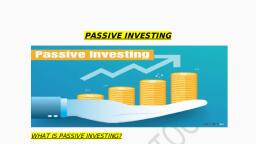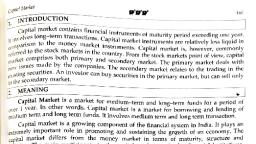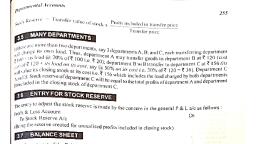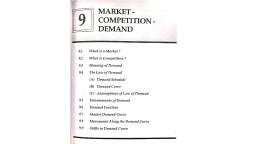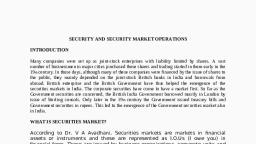Page 1 :
Index, 1. Introduction to Stock Market, 2. What is SEBI, 3. List of exchanges in India, 4. What is DEMAT account, 5. What is a Depositary, 6. What is Trading account, 7. Market timings, 8. Equity Market, 9. Derivatives / F&O Market, 10.Diff^ between Delivery and Derivative trades, 11.Currency & Commodities market, 12.Types of trading, 13.Index, 14.General terms
Page 2 :
Introduction to Stock Market, , What is stock market?, The stock market refers to the collection of markets and exchanges where the regular, activities of buying, selling and issuance of shares of publicly held companies take place., , Why do companies come to Share Market?, A company enters the primary market to raise funds. It is in the primary market that a company, gets registered to issue shares to the public and raise money. Companies generally get listed on, the stock exchange through the primary market route., , IPO
Page 3 :
Initial Public Offering (IPO) is the process by which a private company can go public by sale of, its stocks to general public. It could be a new, young company or an old company which decides, to be listed on an exchange and hence goes public., Companies can raise equity capital with the help of an IPO by issuing new shares to the public, or the existing shareholders can sell their shares to the public without raising any fresh capital., , ASBA, , ASBA process facilitates retail individual investors bidding at a cut-off, with a single option, to, apply through Self Certified Syndicate Banks (SCSBs), in which the investors have bank accounts., SCSBs are those banks which satisfy the conditions laid by SEBI. SCSBs would accept the, applications, verify the application, block the fund to the extent of bid payment amount, upload, the details in the web based bidding system of NSE, unblock once basis of allotment is finalized, and transfer the amount for allotted shares to the issuer., Applications Supported by Blocked Amount (ASBA) is a process developed by the India's Stock, Market Regulator SEBI for applying to IPO. In ASBA, an IPO applicant's account doesn't get, debited until shares are allotted to them.
Page 4 :
ASBA allows the investors money to remain with the bank till the shares are allotted after the, IPO. Only then does the money transfer out of the investors account to the company. This, eliminates the need for refunds on shares not being allotted.
Page 5 :
What is SEBI?, , Securities and Exchange Board of India (SEBI) is the regulatory body for the stock market of, India. It was established in 1992, under section 3 of SEBI Act. SEBI has power to regulate all, market intermediaries and also to penalize them in case of fraudulent activities and unfair trade, practices. SEBI has the authority to regulate and develop the stock market., , Objectives of SEBI:, ▪ To regulate the activities of the stock exchange, ▪ Protecting the rights of investors, ▪ Preventing fraudulent and unfair activities, ▪ Develop a code of conduct for intermediaries, , Purpose of SEBI:, The main purpose for which SEBI was setup was to keep a check on malpractices and protect, the interests of investors. It was set up in order to meet the needs of three groups:, Issuers: To provide a marketplace in which they can raise capital easily., Investors: To provide protection and supply of information., Intermediaries: To provide a competitive professional market.
Page 6 :
List of exchanges in India, , 1. NSE, The National Stock Exchange (NSE) is the leading stock exchange of India, located in Mumbai., It was established in the year 1992 as the first demutualized electronic exchange in the country., NSE was the first exchange in the country to provide a modern, fully automated screen-based, electronic trading system which offered easy trading facility to the investors spread across the, country., , 2. BSE, The Bombay Stock Exchange (BSE) is India's & Asia's oldest exchange which began 140 years, ago under a banyan tree! It was India's primary exchange till the emergence of the NSE. Evolving, from an open outcry system, the BSE also shifted to electronic trading mode in a record 50 Days., With increased connectivity, the BSE was the first Indian Exchange to launch Mobile Trading in, 2010. Despite being 140 years old, the BSE is India's fastest exchange with 6 micro seconds!, , There are few more exchanges in India which are not so active in the market.
Page 7 :
What is DEMAT Account, , DEMAT account or dematerialized account provides the facility of holding shares and securities, in electronic format. During online trading, shares are bought and held in a DEMAT account,, thus facilitating easy trade for users. A DEMAT account holds all the investments an individual, makes in shares, government securities, exchange traded funds, bonds and mutual funds in one, place., In India, DEMAT account service is provided by depositories such as NSDL and CDSL through, intermediaries / Depository Participant / Stock Broker. The charges of DEMAT account vary as, per the volume held in the account, type subscribed, and the terms and conditions laid by the, depository and the stock broker., , Benefits of DEMAT Account:, •, , Easy and a convenient way to hold securities., , •, , Safer than paper-shares., Reduced paperwork for transfer of securities., , •, •, •, •, •, , •, •, , Reduced transaction cost., No "odd lot" problem: even one share can be sold, Transmission of securities is done by DP, eliminating the need for notifying companies., Automatic credit into DEMAT account for shares arising out of bonus/split,, consolidation/merger, etc., A single DEMAT account can hold investments in both equity and debt instruments., Traders can work from anywhere.
Page 8 :
HOLDINGS, Holdings are basically shares that an investor can keep in his/her DEMAT account for long term., A holding represents the securities (stocks or bonds) held in the market. Imagine a bucket filled, with rocks, the bucket is the DEMAT account and each rock is a single stock or bond holding., The sum of all rocks (stocks or bonds) equals the total number of holdings.
Page 9 :
What is a Depositary, A depository is a facility such as a building, office, or warehouse in which something is deposited, for storage or safeguarding. It can refer to an organization, bank, or institution that holds, securities and assists in the trading of securities. The term can also refer to a depository, institution that accepts currency deposits from customers., There are two depositaries in India and those are NSDL and CDSL., National Securities Depository Limited (NSDL) is an Indian central securities depository based, in Mumbai. It was established on 8th November 1996 as the first electronic securities depository, in India with national coverage. It was established based on a suggestion by a national institution, responsible for the economic development of India., &, Central Depository Services Limited (CDSL) is the second Indian central securities, depository based in Mumbai. Its main function is the holding securities either in certificated or, dematerialized form, to enable book entry transfer of securities.
Page 10 :
What is Trading Account, , Trading account is a special account through which you can conduct transactions. Without one,, you cannot trade in stock market. A trading account shows all the transactions that are done, over a period of time. It gives us complete information on the amount that has been debited &, also the amount that has been credited in the Trading Account, For example: You have Rs.100 in your wallet. You go to a shop and tell the seller that you want, a packet of chips, you check the price, and finalize the transaction. Then, you take the money, out of your wallet and give it to the seller. In this case, the wallet acts as the DEMAT account,, while you act as the trading account.
Page 11 :
Market timings, Segment, , Timings, , Equity & FNO, , 09:15 AM - 3:30 PM, , Commodity, , 09:00:00 AM - 11:30 PM or 11:55 PM, , Currency, , 09:00 AM - 05:00 PM, , Cross currency, , 09:00 AM - 07:30 PM
Page 12 :
Equity Market, Definition of Equity Market:, An equity market is a market in which shares are issued and traded, either through exchanges, or over-the-counter markets. Also known as the stock market, it is one of the most vital areas, of a market economy because it gives companies access to capital and investors a slice of, ownership in a company with the potential to realize gains based on its future performance., , Breaking Down of Equity Market:, Equity markets are the meeting point for buyers and sellers of stocks. The securities traded in, the equity market can be either public stocks, which are those listed on the stock exchange, or, privately traded stocks., , Trading in the Equity Market:, In the equity market, investors bid for stocks by offering a certain price, and sellers ask for a, specific price. When these two prices match, a sale occurs. Often, there are many investors, bidding on the same stock. When this occurs, the first investor to place the bid is the first to, get the stock. When a buyer will pay any price for the stock, he or she is buying at market, value; similarly, when a seller will take any price for the stock, he or she is selling at market, value., Companies sell stocks in order to get capital to grow their businesses. When a company offers, stocks on the market, it means the company is publicly traded, and each stock represents a, piece of ownership. This appeal to investors, and when a company does well, its investors are, rewarded as the value of their stocks rise. The risk comes when a company is not doing well,, and its stock value may fall. Stocks can be bought and sold easily and quickly, and the activity, surrounding a certain stock impacts its value. For example, when there is high demand to, invest in the company, the price of the stock tends to rise, and when many investors want to, sell their stocks, the value goes down., , Delivery Trading, Delivery Trading is said to be one of the secured ways of trading in stock market. If we buy, shares today and sell them after 1 day then the type of trading is called as Delivery Trading., The main advantage of Delivery Trading is that, the Fear for Loss of Money is very less when
Page 13 :
compared with Intraday Trading. Customer can take delivery for undefined period and need, not sell them on the same day with loss, even if the market price of share value reduces. This, is a kind of long-term investments., , Definition of 'Squaring Off', Squaring off is a trading style used by investors/traders mostly in day trading, in which a trader, buys or sells a particular quantity of an asset (mostly stocks) and later in the day reverses the, transaction, in the hope of earning a profit (price difference net of broker charges and tax)., For example: Person A buys 100 shares of Reliance from the BSE Sensex through a broker for a, price or Rs 10 per share. Later in the day, Person A sells all the shares for Rs 12 per share and, by paying broker charges of Rs 10. The net profit A earns is Rs (200-10)= Rs 190.
Page 14 :
Derivatives / F&O Market, What are Derivatives?, A derivative is a financial instrument whose value is derived from the value of another, asset, which is known as the underlying., When the price of the underlying changes, the value of the derivative also changes., A Derivative is not a product. It is a contract that derives its value from changes in the, price of the underlying., Example: The value of a gold futures contract is derived from the value of the underlying asset, i.e. Gold., , Derivatives are divided into 2 parts –, Derivatives, , Futures, , Options, , Futures, What is a Futures Contract, , A futures contract is a legal agreement to buy or sell a particular commodity or asset at a, predetermined price at a specified time in the future. Futures contracts are standardized for, quality and quantity to facilitate trading on a futures exchange. The buyer of a futures contract, is taking on the obligation to buy the underlying asset when the futures contract expires. The, seller of the futures contract is taking on the obligation to provide the underlying asset at the, expiration date.
Page 15 :
Lot Size-, , A lot size is the minimum quantity to be purchased when entering a particular contract. The, future contract can only be brought in multiples of that lot size, Example- A lot size of Reliance future is 500qty one can only buy future of 500qty or in, multiples of 500qty, Future price-, , There are several factors which determines future price basically it is derived from the price of, underlying assets other than this expiry date, volatility, Open Interest, etc also determines the, price of future contract., Contract Name-One can buy /Sell future of current month + 2 months maximum, Example- If you want to buy a future contract one can buy current month i.e. March one can, buy for April or May., Index Future-Index is a basket of particular stocks(Depending on the nature of index) which, come together and make an index, Index futures are the future contracts of these index., , Options, What are Option Contracts?, , An options contract is an agreement between a buyer and seller that gives the purchaser of, the option the right to buy or sell a particular asset at a later date at an agreed upon, price. Options contracts are often used in securities, There are 2 types of Options, • Call Option(Bullish), • Put Option (Bearish)
Page 16 :
Call Option –, , Call option refers to the Assuming that the stock or underlying asset price will Rise. Technically, a call option is defined as an option to buy assets at an agreed price on or before a particular, date., Put Option –, , Put option refers to the Assuming that the stock or underlying asset price will Fall. Technically, a put option is defined as an option to sell assets at an agreed price on or before a particular, date., Contract Name (Expiry)-, , Similar to future contract expiry one can buy /Sell Option of current month + 2 months, maximum, Example- If you want to buy a Option contract one can buy current month i.e. March one can, buy for April or May., Option Premium-, , Premium is the amount paid to get the right., Example-Let’s say you want to buy a house but before buying you give a token to the seller, both agreeing that the Buyer may buy the said house at a particular date and at a particular, price and the sell may sell the said house at that particular date and price., So the amount which is given to the seller i.e. token is the premium., Premium is basically the amount required to be paid to get that particular right, As the, example suggest that the buyer and seller may have right to buy/sell but not a obligation, (Compulsory) the sell/buyer may deny the contract., , Option Strike Price-, , Strike Price is basically a price you are quoting option for., Example- Let take a price scale of Reliance Industries Stock
Page 17 :
|---------------------|---------------------|-----------------------|-----------------------|--------------------|-------------|, 980, , 990, , 1000, , 1010, , 1020, , 1030, , 1040, , CMP, Put (Bearish), , Call (Bullish), , The strike price is defined as the price at which the holder of options can buy (in the case of a, call option) or sell (in the case of a put option) the underlying security when the option is, exercised. Hence, strike price is also known as exercise price., , Index Future-, , Index is a basket of particular stocks (Depending on the nature of index) which come together, and make an index, Index Options are the option contracts of these indexes
Page 18 :
Difference between Delivery & Derivative Trades, , Delivery Trading, , Derivative Trading, , When you purchase shares and hold them overnight,, then you take delivery of the shares. These shares, are added to your DEMAT account. You enjoy, complete ownership of the stocks., In delivery, since stocks can be sold whenever the, investor wants, leverage is not provided because you, have to use the amount that is available in your, account., , Derivatives are essentially just standard contracts, that are traded off the back of underlying assets and, therefore respond more sensitively to underlying, price fluctuations., In derivatives, leverage is built in to the nature of the, contract. For example, Rs 1,000 worth of options, might actually control Rs 10,000 worth of stocks,, thus when the stock value increases 1%, the trader, can actually bank a profit of 10% on the transaction., This can pave the way for derivatives traders to, make more money over a shorter period of time., While it is entirely possible to earn a hefty rate of, return on your derivatives investment pretty quickly,, it's also more than possible to lose the bulk of your, exposure to a position in a matter of seconds. Thus,, it is recommended that only traders with a large, appetite should go for derivatives., Derivatives can be wildly more volatile than their, share trading counterparts. Greater volatility means, prices are likely to swing more heavily in a profitable, direction, but it also opens up the possibility to, heavy losses, so coping with heightened volatility is, something of a balancing act., , The risk in delivery trading is very less because the, shares remain in your possession until you decide to, sell them, which can be in days, weeks, months or, years. You enjoy complete ownership of your stocks., , In delivery, shares remain fundamentally volatile in, nature, they are not subjected to movements that, are as wild as derivatives.
Page 19 :
CDS / Currency, What is Currency Markets?, The currency market includes the Foreign Currency Market and the Euro-currency Market. The, Foreign Currency Market is virtual. There is no one central physical location that is the foreign, currency market. It exists in the dealing rooms of various central banks, large international banks, and, some large corporations. The dealing rooms are connected via telephone, computer, and fax. Some, countries co-locate their dealing rooms in one center. The Euro-currency Market is where borrowing, and lending of currency takes place. Interest rates for the various currencies are set in this market., Trading on the Foreign Exchange Market establishes rates of exchange for currency. Exchange rates, are constantly fluctuating on the forex market. As demand rises and falls for particular currencies,, their exchange rates adjust accordingly. A rate of exchange for currencies is the ratio at which one, currency is exchanged for another., , MCX / Commodity, What is the Commodity Market?, A commodity market is a physical or virtual marketplace for buying, selling and trading raw or, primary products, and there are currently about 50 major commodity markets worldwide that, facilitate investment trade in approximately 100 primary commodities., Commodities are split into two types: hard and soft commodities. Hard commodities are, typically natural resources that must be mined or extracted (such as gold, rubber and oil),, whereas soft commodities are agricultural products or livestock (such as corn, wheat, coffee,, sugar, soybeans and pork)., , Types of Commodities, •, •, •, •, , Metals (such as gold, silver, platinum and copper), Energy (such as crude oil, heating oil, natural gas and gasoline), Livestock and Meat (including lean hogs, pork bellies, live cattle and feeder cattle), Agricultural (including corn, soybeans, wheat, rice, cocoa, coffee, cotton and sugar)
Page 20 :
Types of Trading, , CNC / Cash and carry, CNC is used for buying equity shares in delivery.So while buying shares in delivery the client requires, complete margin of the shares eg-If a client wants to buy 100 shares of Reliance for delivery and the, current market price of Reliance is 1000 then client requires 1000*100 i.e 100000rs to do this, transaction., Intraday, Intraday trading involves buying and selling of stocks within the same trading day. Here stocks are, purchased, not with an intention to invest, but for the purpose of earning profits by harnessing the, movement of stock indices. Thus, the fluctuations in the prices of the stocks are harnessed to earn, profits from the trading of stocks., , Types of Intraday Trading:, MIS – Marginal Intraday Square-off, As the name suggests, it is an intraday order that gets squared off the same day; but lets you transact, with low margin in cash, futures and currencies futures., , CO – Cover Order, A Cover Order is a special type of order through which the user can take an intra-day position and, take advantage of extra exposure while being protected through a stop loss order. Here is how it, works. The system will place two orders simultaneously: a market order and a corresponding stop loss
Page 21 :
market order which would only get triggered at the specified stop loss trigger price. If the trigger price, is hit, the stop loss order gets executed as a market order. The combination of both these orders, being placed simultaneously is known as a Cover Order. Cover Orders help you limit any potential, losses that could be incurred on a position., How Cover Orders Work:, •, •, •, •, , A Cover Order is basically a two legged order. The client needs to place a buy/sell order with, compulsory corresponding stop loss order in the opposite direction., The first entry order will always be a market order., The corresponding stop loss order will sit in the order book as a Stop-Loss trigger pending, order; once the trigger price hits the stop loss limit price, it gets triggered as a market order., The trigger price range will be defined daily and the client must place the stop loss order within, the specified range. For example, suppose Reliance Industries is trading at Rs. 900 and the, range is specified as 10%. In this case the client can specify the Stop Loss order between the, price ranges of Rs.810 to 990 as the trigger price., , BO – Bracket Order, Bracket orders are designed to help limit your loss and lock in a profit by "bracketing" an order with, two opposite-side orders. A BUY order is bracketed by a high-side sell limit order and a low-side sell, stop order. A SELL order is bracketed by a high-side buy stop order and a low side buys limit order., The order quantity for the high and low side bracket orders matches the original order quantity. By, default, the bracket order is offset from the current price by 1.0. This offset amount can be changed, on the order line for a specific order, or modified at the default level for an instrument, contract or, strategy using the Order Presets feature in Global Configuration
Page 22 :
General terms, INDEX, A stock index or stock market index is a measurement of a section of the stock market. It is, computed from the prices of selected stocks. It is a tool used by investors and financial, managers to describe the market, and to compare the return on specific investments., You may often hear people speaking that the ‘market’ fell one day, or that the ‘market’ jumped., However, if you read the stock table, you will realize that not all stocks rose or fell. There were, some which moved in the opposite direction. This is called INDEX., , NIFTY 50, The NIFTY 50 index is National Stock Exchange of India's benchmark broad based stock market, index for the Indian equity market. Full form of NIFTY is National Stock Exchange Fifty. It, comprises of 50 Indian company stocks in 12 sectors and is one of the main stock indices used, in India.NIFTY 50 Index has shaped up as a largest single financial product in India, with an, ecosystem comprising of exchange traded funds, exchange-traded futures and options, other, index funds and OTC derivatives., , SENSEX, The BSE SENSEX is a free-float market-weighted stock market index of 30 well-established and, financially sound companies listed on Bombay Stock Exchange. The 30 component companies, which are some of the largest and most actively traded stocks, are representative of, various industrial sectors of the Indian economy., , Volatility, Volatility is the range of price change that a security experiences over a given period of time. If, the price stays relatively stable, the security has low volatility. A highly volatile security is one, that hits new highs and lows, moves erratically, and experiences rapid increases and dramatic, falls.
Page 23 :
Liquidity, Liquidity describes the degree to which an asset or security can be quickly bought or sold in the, market without affecting the asset's price., Market liquidity refers to the extent to which a market, such as a country's stock market or a, city's real estate market, allows assets to be bought and sold at stable prices. Cash is considered, the most liquid asset, while real estate, fine art and collectibles are all relatively illiquid., , What is Pledge / Un-pledge of share?, Pledging of shares basically means mortgaging of shares in return of funds to trade in the market. Unpledge is vice versa of pledging of shares. It takes Rs 60 + GST to pledge shares, The timings for share, pledge and un-pledge is if placed a request before 4.00 pm then working 24 hours will be taken for, the process (4pm to 7pm it’s not allowed). After 7pm if the request is placed then 48 working hours, will be taken for the process (4pm to 7pm it’s not allowed). For instant sell for stock plus a charge of, Rs 90 + GST will be charged after 30 minutes of the submission of OTP in back office.To place pledge, and un-pledge requests, go to SAMCO STAR -> Holdings -> Pledge/Un-pledge., , What is open Position?, An open position in investing is any trade, established or entered, that has yet to be closed with an, opposing trade. An open position can exist following a buy, a long position or a sell or a short position., In any case, the position remains open until an opposing trade takes place.
Page 24 :
What is margin Position?, Any position taken in the market using the Cash plus Product with the margin provided by SAMCO on, the cash balance of the client is known as Margin position., , What is Ledger?, A ledger is the principal book or computer file for recording and totaling economic transactions, measured in terms of a monetary unit of account by account type, with debits and credits in separate, columns and a beginning monetary balance and ending monetary balance for each account., , What is Trade book?, A trading book is the portfolio of financial instruments held by a brokerage or bank. Financial, instruments in a trading book are purchased or sold for reasons including to facilitate trading for the, institution's customers, to profit from trading spreads between the bid and ask prices, or to hedge, against various types of risk. Trading books can range in size from hundreds of thousands of dollars to, tens of billions depending on the size of the institution., , What is Contract note?, Contract note is a legal document which every stock brokers issues to their investors who invest into, shares or other listed securities through them. In normal trading cycle, when an investor wishes to, invest or sell securities he contracts a stock broker., , What is ISIN number?, The International Securities Identification Number (ISIN) is a code that uniquely identifies a specific, securities issue. Every stock listed in the stock market will have a unique ISIN number., , What is Bhavcopy?, Bhavcopy is a compilation of Day's Open + Day's High + Day's Low + Day's Closing prices of all scripts., It includes volumes and values too. Most of the Brokers need this for settlement purpose. Many, analysts use these to predict the future movement of stocks as well as indices as this is the only, authentic source of information for them.






